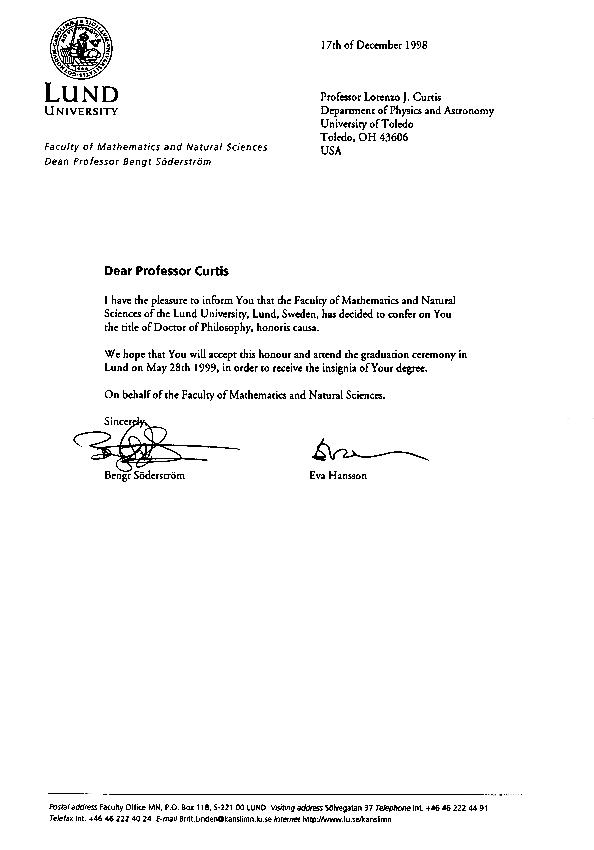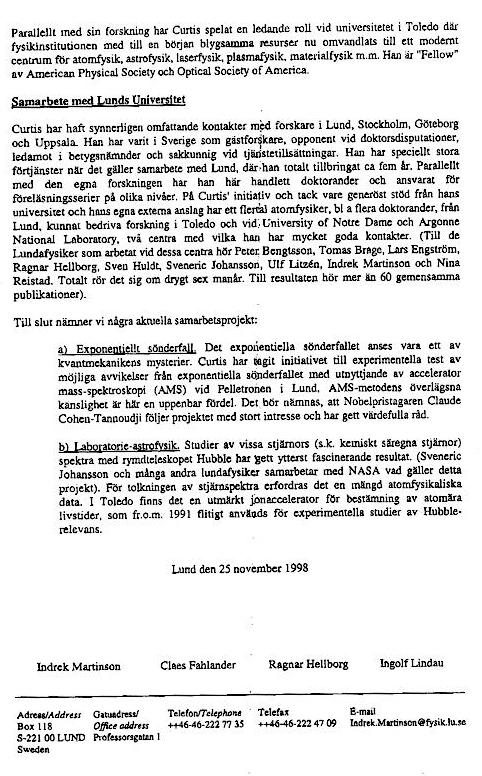


University of Lund
Department of Physics
Atomic Spectroscopy
Mathematics and Natural Science
Faculty Board of Directors
University of Lund
The undersigned propose herewith that professor Lorenzo J. Curtis, Toledo Ohio, USA, be selected to receive an Honorary Doctorate at the University of Lund. We propose this in part because of Curtis' distinguished research, which is of high international class, and in part because of his exceedingly comprehensive and successful collaboration with researchers at the Institute of Physics in Lund.
Research Accomplishments
Curtis (b. 1935) is "Distinguished Professor" in the Department of Physics and Astronomy at the University of Toledo. His present research covers both theoretical and experimental atomic physics, and he occupies an internationally leading position within his specialty area, semi-empirical atomic physics. His results are of significant fundamental scientific value, and have important applications in astrophysics, laser physics, and plasma physics and fusion research.
Curtis began his research studies in elementary particle physics and obtained his doctorate at the University of Michigan. Thereafter he has primarily worked in the broad areas of atomic physics. Here he has, by great analytical and numerical skill, further developed and refined the semi-empirical methods that were first introduced by Lund Professor Bengt Edlén over 40 years ago.
Curtis has thereby obtained spectroscopic data that are, in many cases, more accurate than the result of any individual experimental measurement or purely theoretical calculation. His work is especially appreciated by astrophysicists and controlled nuclear fusion researchers, who require large quantities of highly reliable data for the diagnosis of plasmas in space and in the laboratory. Curtis has also developed a highly effective method which has, for all practical purposes, eliminated the cascade problem in the determination of atomic lifetimes. Another of his important results was the first detection of an optical transition in a negative ion. Moreover, he has carried out pioneering studies of the excitation process in the interaction of ions with solid surfaces. His attached Curriculum Vitae shows a large number of publications in the prestige journals Physical Review Letters and Physics Letters. Since 1979 he has continually received significant Research Funding from the Department of Energy in Washington , which illustrates his ability to continually renew and reinvigorate his research.
In parallel with his research Curtis has played a leading role at the University of Toledo, where a Physics Department which began with very modest resources has been transformed into a modern center for Atomic Physics,. Astrophysics, Laser Physics, Plasma Physics, Materials Science, and more. He is a "Fellow" of both the American Physical Society and the Optical Society of America.
Collaboration with the University of Lund
Curtis has had exceedingly broad contacts with researchers in Lund, Stockholm, Gothenberg, and Uppsala. He has been in Sweden as a guest researcher, as a principal opponent at Doctoral Disputations, as a delegate on doctoral advisory committees, and as an expert in evaluating Swedish tenure promotions. He has made especially large contributions concerning collaboration with Lund, where he spent a total of more than five full years. In parallel with his own research he has directed theses for Lund doctoral students and taken the responsibility for teaching courses and giving lectures at many different levels. On Curtis' initiative, and thanks to the generous support of his University and his own research funding, a large number of atomic physicists from Lund (including several doctoral candidates) have been able to carry out research at the University of Toledo, as well as at the University of Notre Dame and Argonne National Laboratory , two research at which he has very strong contacts. (Among the Lund physicists who have worked at these centers are Peter Bengtsson, Tomas Brage, Lars Engström, Ragnar Hellborg, Sven Huldt, Sveneric Johansson, Ulf Litzén, Indrek Martinson and Nina Reistad. In total this amounts to over six man-years. This has resulted in over 60 refereed scientific publications.)
In conclusion we list several ongoing collaborative
projects:
a) Exponential Decay The exponential decay law is one of the prevailing mysteries of modern quantum mechanics. On Curtis' initiative an experimental test is being made of possible deviations from the exponential law through the utilization of the Accelerator Mass Spectroscopy (AMS) facility at the Pelletron accelerator in Lund. The unprecedented sensitivity of the AMS method is here a significant advantage. It should also be mentioned here that the Nobel Laureate Claude Cohen-Tannoudji is following Curtis' experiment with great interest and has given significant advice.
b) Laboratory Astrophysics Studies of the spectra of certain stars (the so-called Chemically Peculiar Stars) with the Hubble Space Telescope have provided some extremely fascinating results. (Sveneric Johansson and many other Lund researchers collaborate with NASA on work concerned with this project.) Interpretation these stellar spectra requires a large amount of new atomic physics data. The Toledo laboratory possesses an excellent ion accelerator for the determination of atomic lifetimes which, since 1991, has been highly productively applied to experimental studies of relevance to these Hubble data.
Lund the 25th of November 1998
Indrek Martinson Claes Fahlander Ragnar Hellborg Ingolf Lindau
Attachment 1: Curriculum Vitae for L. J. Curtis
Attachment 2: Letter from C. Cohen-Tannoudji